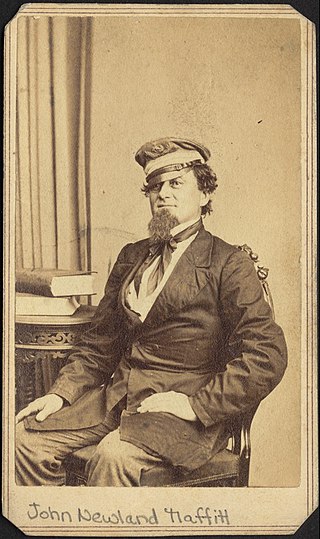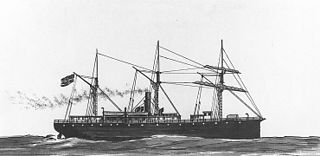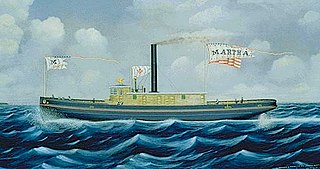The first USS Sonoma was a sidewheel gunboat that served in the United States Navy during the American Civil War. She was named for Sonoma Creek in northern California, Sonoma County, California, and the town of Sonoma, California, that in turn were named for one of the chiefs of the Chocuyen Indians of that region.

John Newland Maffitt was an officer in the Confederate States Navy who was nicknamed the "Prince of Privateers" due to his success as a blockade runner and commerce raider in the U.S. Civil War.

USS Hendrick Hudson was a schooner-rigged screw steamer.

The third USS Montgomery was a wooden screw steamer in the Union Navy during the American Civil War.

USS Stars and Stripes was a 407-ton steamer acquired by the U.S. Navy and put to use by the Union during the American Civil War.

The first USS Pocahontas, a screw steamer built at Medford, Massachusetts in 1852 as City of Boston, and purchased by the Navy at Boston, Massachusetts on 20 March 1855, was the first United States Navy ship to be named for Pocahontas, the Algonquian wife of Virginia colonist John Rolfe. She was originally commissioned as USS Despatch – the second U.S. Navy ship of that name – on 17 January 1856, with Lieutenant T. M. Crossan in command, and was recommissioned and renamed in 1860, seeing action in the American Civil War. As Pocahontas, one of her junior officers was Alfred Thayer Mahan, who would later achieve international fame as a military writer and theorist of naval power.

USS Huron was a Unadilla-class gunboat built for the United States Navy during the American Civil War for blockage duty against the ports and rivers of the Confederate States of America.

USS Aries was an 820-ton iron screw steamer built at Sunderland, England, during 1861–1862, intended for employment as a blockade runner during the American Civil War. She was captured by Union Navy forces during the Union blockade of the Confederate States of America, and was commissioned as a Union gunboat. Aries was named for the constellation.

USS Quaker City was a heavy, 1,428 long tons (1,451 t) sidewheel steamship leased by the Union Navy at the start of the American Civil War. She was subsequently purchased by the navy, outfitted with a powerful 20-pounder long rifle, and assigned to help enforce the Union blockade of the ports of the Confederate States of America.
USS Two Sisters was a small 54-ton captured Confederate schooner acquired by the Union Navy from the prize court during the American Civil War.
USS Patroon was a screw steamer acquired by the United States Navy during the American Civil War. The Union Navy used her to patrol off the coast of the Confederate States of America to enforce the Union blockade.

USS Isaac Smith was a screw steamer acquired by the United States Navy during the American Civil War. She was used by the Union Navy to patrol navigable waterways of the Confederate States of America to prevent the Confederacy from trading with other countries. In 1863, she became the only warship in the American Civil War to be captured by enemy land forces. She then served in the Confederate States Navy as CSS Stono until she was wrecked.
USS Magnolia was a steamer captured by the Union Navy during the American Civil War. She was planned to be used by the Union Navy to patrol navigable waterways of the Confederacy to prevent the South from trading with other countries.
USS Mobile was a steamer captured by the Union Navy during the American Civil War. She was used by the Union Navy as part of blockade forces to prevent Confederate forces from trading with other countries.
USS Tioga was a large steamer with powerful guns, acquired by the Union Navy during the American Civil War.
USS Wyandotte, originally USS Western Port, was a steamer acquired by the Navy as a gunboat for the Paraguay expedition in 1858. When the crisis of the American Civil War occurred, she operated in support of the Union Navy blockade of Confederate waterways.
The third USS Union was a heavy (1,114-ton) steamer with a powerful 12-inch rifled gun purchased by the United States Navy during the American Civil War.

USS Violet was a 166-ton steamer acquired by the U.S. Navy for use during the American Civil War.

During the American Civil War, blockade runners were used to get supplies through the Union blockade of the Confederate States of America that extended some 3,500 miles (5,600 km) along the Atlantic and Gulf of Mexico coastlines and the lower Mississippi River. The Confederacy had little industrial capability and could not indigenously produce the quantity of arms and other supplies needed to fight against the Union. To meet this need, numerous blockade runners were constructed in the British Isles and were used to import the guns, ordnance and other supplies that the Confederacy desperately needed, in exchange for cotton that the British textile industry needed greatly. To penetrate the blockade, these relatively lightweight shallow draft ships, mostly built in British shipyards and specially designed for speed, but not suited for transporting large quantities of cotton, had to cruise undetected, usually at night, through the Union blockade. The typical blockade runners were privately owned vessels often operating with a letter of marque issued by the Confederate government. If spotted, the blockade runners would attempt to outmaneuver or simply outrun any Union Navy warships on blockade patrol, often successfully.
USS Isilda, sometimes spelled Ezilda, was an armed schooner in commission in the United States Navy from 1861 to 1863. As part of the Union Navy, she saw service during the American Civil War.











